
Since Pro Circuit New York, there have been several interesting developments in the Golden Age metagame. The banning of
Overload and the neutering of the Light Show decks centered on
Rama-Tut and
Dr. Light, Master of Holograms were big moves. Green Lantern and Marvel Knights builds emerged as top tier contenders. Finally, the most anticipated set since
Marvel Origins,
The Avengers, has players scrambling to fit out their newest ideas before the next PCQ or $10K reaches their area.
Before I go any further, I want to put a few things in context for you. Two decks, regardless of whether they win every tournament, dominate the current Golden Age metagame. Those decks are Curve Sentinels and Teen Titans. Knowing how these decks operate will give you the necessary grounding to either pilot them to success or maximize your chances of defeating them. While I intend to cover Curve Sentinels in the near future, I have a bit more experience with the Teen Titans, so I’ll begin with them.
Teen Titans is the most flexible and synergistic affiliation. Whereas most affiliations have obvious and narrow themes, the Teen Titans have access to a wondrous collection of abilities. While their capacity for devastating team attacks and ability to stun characters outside of combat are the Titans’ most lethal hallmarks, their access to ancillary benefits—such as direct endurance loss, KO’d pile manipulation, and numerical supremacy—contributes substantially to their impressive package.
Perhaps because of the range of options available on each turn, the Teen Titans are commonly considered to be difficult to play. This may be true for the uninitiated; however, for more experienced players, the deck is hardly indecipherable. With this article and the following matchup guide, I want to highlight the important issues and tensions within today’s Teen Titans builds. For the sake of brevity, unlike my last series on the League of Assassins, this article will not seek to detail every possible card selection or inquiry you may have. This week, I want to look at the affiliation first from a historical perspective. From there, I will give my current build, explaining where I differ from the norm and for what reasons. For beginners, I have written on this subject in a more elementary fashion before, so if you are interested, you can follow on from the footnote*.
The Teen Titans have tasted success at every level of the game. Looking back at the lists that cemented the Titans in the top tier shows us how some of the better players in the game have approached the deck. From there, we will be able to make our own decisions with regard to the most up-to-date build.
Jason Green
7-0, Day 1 PC Indy 2004
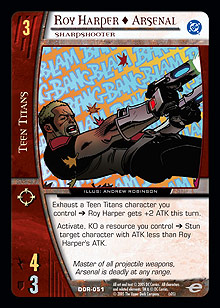 Characters
Characters
4 Beast Boy
2 Connor Kent ◊ Superboy, Tactile Telekinetic
4 Dawn Granger ◊ Dove
4 Garth ◊ Tempest
3 Hank Hall ◊ Hawk
1 Koriand’r ◊ Starfire
4 Red Star
4 Roy Harper ◊ Arsenal, Sharpshooter
4 Terra
4 Tim Drake ◊ Robin, Young Detective
Plot Twists
3 Heroic Sacrifice
4 Not So Fast
3 Overload
4 Teen Titans Go!
Locations
4 Tamaran
4 Titans Tower
3 USS Argus
2 Optitron
Jason took his list to an undefeated record on the first day of the inaugural Pro Circuit, PC Indy 2004. At the time, Vs. was almost strictly a combat-oriented game, and this list responds to that by including four copies of Titans Tower and three Heroic Sacrifices. The early rise of Overload was clearly evident, and Jason has his own as well as the maximum available copies of Not So Fast. Where Jason’s list really comes into its own is its Terra count. While her power level is common knowledge now, Terra was tech at this event. Great against weenie and utility decks and pivotal in the important task of dominating an as-yet undefined mirror match, Terra put Jason’s list over the top. Current builds are much different, but we can see the raw power of the affiliation rearing its head even at this early stage.
Ryan Jones
PCLA 2004 Champion
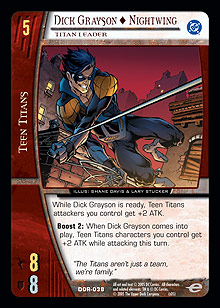 Characters
Characters
1 Cassie Sandsmark ◊ Wonder Girl
1 Connor Kent ◊ Superboy, Tactile Telekinetic
3 Dawn Granger ◊ Dove
1 Dick Grayson ◊ Nightwing, Titan Leader
4 Garth ◊ Tempest
3 Hank Hall ◊ Hawk
1 Koriand’r ◊ Starfire
3 Red Star
4 Roy Harper ◊ Arsenal, Sharpshooter
4 Terra
4 Tim Drake ◊ Robin, Young Detective
Plot Twists
3 Finishing Move
2 Foiled
2 Heroic Sacrifice
2 Ka-Boom!
2 Overload
3 Press the Attack
3 Savage Beatdown
3 Teen Titans Go!
Locations
2 Optitron
3 USS Argus
3 Tamaran
3 Titans Tower
This is probably the most famous of all Teen Titans incarnations. Ryan took out the second Pro Circuit with a list and style that had been popularized by then-teammate Rob Leander. Superficially, the numbers of the deck seem to lack focus. However, the redundancy of the attack plan—built around Tim Drake and Teen Titans Go!—and the defensive plan—built around Roy Harper and Press The Attack—granted Ryan a lot of freedom to factor in an unrivaled support cast. Although the lists would gradually tighten up, this deck provides the foundation for future Teen Titans builds.
Adam Prosak
$10K San Diego Champion
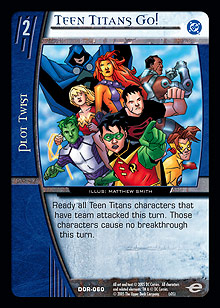 Characters
Characters
1 Pantha
2 Roy Harper ◊ Speedy
2 Dawn Granger ◊ Dove
3 Hank Hall ◊ Hawk
4 Tim Drake ◊ Robin, Young Detective
4 Roy Harper ◊ Arsenal
2 Beast Boy
4 Terra
2 Red Star
4 Garth ◊ Tempest
2 Koriand’r ◊ Starfire
Plot Twists
4 Teen Titans Go!
4 Press the Attack
4 Finishing Move
2 Ka-Boom!
2 Heroic Sacrifice
2 Savage Beatdown
Locations
4 USS Argus
4 Tamaran
4 Optitron
Adam has strong views on card counts and deck building that have influenced the design of his deck**. Renowned for his longtime dedication to the affiliation, Adam was recently rewarded for his efforts with a first place finish at $10K San Diego. His deck is similar in templating to the Jones/Leander builds of the past. However, in the post-Overload environment, Adam has streamlined his non-character selection to focus on what he considers integral to the proper function of the deck.
So where does that brief history lesson leave us?
Alex Brown
Teen Titans August 2005
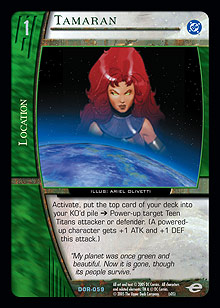 Characters
Characters
1 Pantha
4 Tim Drake ◊ Robin, Young Detective
4 Roy Harper ◊ Arsenal, Sharpshooter
3 Hank Hall ◊ Hawk
3 Dawn Granger ◊ Dove
3 Beast Boy
4 Red Star
4 Terra
4 Garth ◊ Tempest
Plot Twists
4 Teen Titans Go!
4 Press the Attack
4 Finishing Move
3 Foiled
2 Heroic Sacrifice
1 Betrayal
Locations
4 USS Argus
4 Tamaran
4 Optitron
I would hope this is read not merely as a list forged from my own experiences***, but also by close examination of the builds given above. The following paragraphs will outline what I think are the important issues for the deck and how I feel they should be resolved. I will explain where I depart from conventional wisdom, and why.
Foiled vs Ka-Boom!
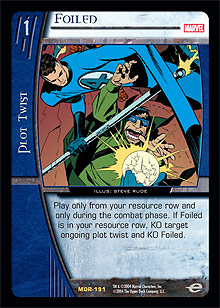 Foiled and Ka-Boom! offer two powerful effects. If a deck can support it, the ability to KO a resource—quite distinct from replacing it—can be game-winning. Combined with Garth ◊ Tempest, we have the makings of a soft-lock for decks that rely on either locations or ongoing plot twists. While there is no question that the Titans, with their ability to play off curve and repeat drops, can support such a plan, there is no consensus as to the number of each that a player should run.
Foiled and Ka-Boom! offer two powerful effects. If a deck can support it, the ability to KO a resource—quite distinct from replacing it—can be game-winning. Combined with Garth ◊ Tempest, we have the makings of a soft-lock for decks that rely on either locations or ongoing plot twists. While there is no question that the Titans, with their ability to play off curve and repeat drops, can support such a plan, there is no consensus as to the number of each that a player should run.
I advocate three copies of Foiled and no Ka-Boom!s. I think the deck can only afford to give up a maximum of four slots to these cards before it loses too much punch, and that you need to run at least three copies to reliably draw one. Put simply, Foiled just outright wins you more games than Ka-Boom! does. Ka-Boom is useful, but locations tend to be more incidental than mandatory. Ongoing plot twists, particularly team-ups, are more often critical to your opponent’s plans. Specifically, Total Anarchy is one of the best answers to a Titans deck. I will concede that both cards are fine; I merely think that Foiled is the more devastating option.
Red Star and Terra Counts
Some affiliations struggle along without an acceptable second-choice 4-drop. Not the Titans. The Teen Titans have access to two different but powerful options on the fourth turn. Red Star shines against Curve strategies. In combination with Tim Drake, Teen Titans Go!, and Tamaran (or simply an old-school power-up), you can wipe out an opponent’s board without losing a man. His capacity for direct endurance loss can finish off an opponent or simply turn up the pressure. On the other hand, Terra annihilates decks that rely on weenie rushes or key small characters such as Shimmer.
There is much debate as to how many of each you should run. In my opinion, you want to run the maximum of each. Red Star and Terra are both critical to the different plans you want to carry out. Red Star is often just as potent on later turns, and Terra is the dominant reason why some match-ups—like TNB—are grossly in your favor. It always helps having greater numbers early on so you can mulligan aggressively, and if you are forced to use Roy Harper ◊ Arsenal, Sharpshooter prematurely, you have an acceptable drop to fill in.
Location Selection
Perhaps the greatest area of consternation for the Titans deck builder is location selection. Terra requires a significant number of locations to be reliably effective. Fortunately, there are quite a few to choose from.
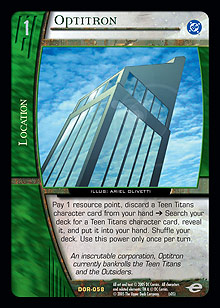 I have long been a fan of USS Argus, which I see as more than a one-turn effect to be replaced by Terra. I find that the Titans play more like a combo deck, where you need to assemble the critical parts in a given matchup to force through the win. Gaining card advantage is not irrelevant, but Garth is sufficient in carrying out that function. I feel that USS Argus, in combination with Optitron, brings a consistency to the deck that other single-affiliation decks cannot match. Unless I have every card I need in my hand, I flip USS Argus as soon as possible, whether I have Terra or not. If you haven’t established a game-winning position by the end of turn 6, when the card disadvantage starts to hurt, you were unlikely to win anyway. USS Argus is a definite four-of.
I have long been a fan of USS Argus, which I see as more than a one-turn effect to be replaced by Terra. I find that the Titans play more like a combo deck, where you need to assemble the critical parts in a given matchup to force through the win. Gaining card advantage is not irrelevant, but Garth is sufficient in carrying out that function. I feel that USS Argus, in combination with Optitron, brings a consistency to the deck that other single-affiliation decks cannot match. Unless I have every card I need in my hand, I flip USS Argus as soon as possible, whether I have Terra or not. If you haven’t established a game-winning position by the end of turn 6, when the card disadvantage starts to hurt, you were unlikely to win anyway. USS Argus is a definite four-of.
Because of the importance of the Argus, I don’t play with Titans Tower anymore. Its effect is strong, but I find that between Teen Titans Go! on offense and Arsenal on defense, I just don’t need it anymore. Considering my plan to aggressively use USS Argus, I can’t really afford the extra card, either.
I value Optitron very highly. Playing four copies allows me to aggressively mulligan for access to Tim Drake on turn 2, which I think is the key to the archetype. It doubles as insurance for getting to Arsenal in the late game, where he is sorely needed, and it can give you extra copies of Red Star and Tim Drake, which can be crucial. The general off-curve nature of the Titans deck really breaks this card open, and I am surprised more players don’t play the maximum number of copies.
For a long time, I was not really a fan of Tamaran, but I finally came to my senses. Not only does the card obviously facilitate the busted antics of Red Star/Tim Drake, it protects your early investments by keeping their average bodies above the curve. Later on, Terra and Garth can both stay out of stun range with a timely flip and power-up. It also provides locations nine through twelve for me; I feel twelve is the right number to support Terra.
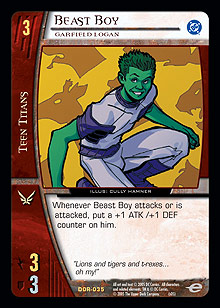 Beast Boy
Beast Boy
While the last issue may have been more generally controversial, for a long time, I had been alone in my advocacy of Beast Boy. Rumors of his susceptibility to Overload were greatly exaggerated, because if you weren’t running Not So Fast, you would rather have your alternate 3-drop stunned on turn 5 than lose Roy Harper or Tim Drake.
I make no bones about it: Beast Boy is still your third choice at the drop. However, one of the least efficient and unduly popular answers to this deck is Flame Trap, and you don’t want to get caught by it by overextending with Hawk/Dove on turn 3. Of course, in matchups where this isn’t relevant, they are the preferred play (though Roy is always the safe play).
That Beast Boy has flight is also far from irrelevant, though the main reason I include three copies of him is less obvious. As stated above, I think hitting Tim Drake on turn 2 is critical, so I mulligan aggressively for him or Optitron. I will throw any other hand, period. I’ve had to tweak the decklist a bit to get away with it, but I think it’s worthwhile. By essentially moving to thirteen 3-drops, between them and USS Argus I can get Tim without worrying about my 3-slot.
Press the Attack
I only moved to four copies of Press after Adam won $10K San Diego, but I cannot believe I didn’t do it earlier. There have been so many games where I only needed a Press the Attack to win and couldn’t get it. Multiple uses of Roy or Terra are obvious and recommended, but Press the Attack also allows you to wipe out your opponent’s characters with Tim Drake/Red Star and friends, leaving behind a single character to repeatedly attack directly. Press the Attack is one of the more inherently “broken” effects the game offers. Some argue that it really only helps you win more, so you don’t need it all the time; I counter that it often helps you win “a turn more,” so it is worth the extra slot. You simply need it sometimes, and I recommend running the maximum number.
Finishing Move
One of the interesting things about Finishing Move is that sometimes when you have it, you play towards using it when you should be playing to force through extra endurance loss. Board control is only a means to achieving endurance loss, and not an end in itself, but for those beyond such temptations, this is a powerful card. In combination with Terra and Roy Harper, it can break you out of A Child Named Valeria locks. Because of the numerical supremacy inherent in the team (typified by Hank/Dawn), it can be used to gain advantage very early on. Against Curve decks, it can remove characters to relieve pressure on non-initiative turns. Key smaller characters can also be removed to dent an entire strategy.
Four copies may seem like overkill, but I think you need to have it all of the time. I will concede that drawing the second copy is rough, but it is not useless. The advantage provided by Finishing Move is too easily exploited in this affiliation; one of the most powerful generic cards in the game would be a terrible waste if not fully utilized here.
Roy Harper ◊ Speedy
I have played this card a lot, and I have never liked it. I can see where it would be good, but decks that rely on 1-drops have left center stage in this format. Even in matchups where Speedy is relevant, he is only good very early on, which often requires Optitron for second turn play. In a one-game format, this is a very risky strategy. If I thought the payoff was worth it, I would still include a copy, but I am unconvinced. Typically what Speedy can achieve is easily attained, if belatedly, by pressure with Hawk/Dove/Tim and Teen Titans Go!. Pantha is a better one-of character to fill the breach.
Koriand’r ◊ Starfire
Players will often forget about Koriand’r, but I still think you have to get pretty lucky to be able to use her. Sometimes just having a large body is better, and you still need to fulfil the character requirement. That she can’t be searched out until turn 7 is a bummer, considering you would probably have wanted to use Arsenal before then.
I think including Koriand’r is a matter of play style. With my four Optitrons and three Beast Boys—as well as full complements of Terra and Red Star, and a copy of Pantha—I have a lot to do in the late game. Typically, I like to use Roy on turn 5 or 6 to ensure I get to my team attack turn expediently. This doesn’t leave a lot of room for Koriand’r. Drawing her early on without an Optitron is suicide, so I prefer to leave her out.
Savage Beatdown
For a long time, Savage Beatdown was a staple of my Teen Titans builds. Although its stock dropped considerably with the removal of Overload, it is still far from useless, as it is a fantastic target for Garth and obviously the best card in the game for ensuring a stun.
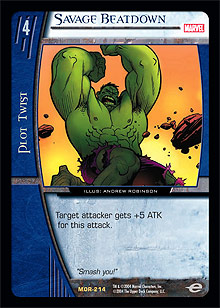 Recently, however, I find it does very little for me, and its effect is random because I can’t afford to devote the slots to making it frequently available. With my remaining slot, I went for Betrayal, as it is very good against your average Sentinel player and is more likely to outright win you the game. I find that nowadays, between Finishing Move and my bolstered Red Star plan, I just don’t make risky attacks–I either team attack repeatedly, or I team attack and KO. Of course, this is only against Curve decks, but that was the only place Beatdown was relevant anyway. I can understand arguments in favor of its reinstatement, but if those arguments win out, more than two copies are needed.
Recently, however, I find it does very little for me, and its effect is random because I can’t afford to devote the slots to making it frequently available. With my remaining slot, I went for Betrayal, as it is very good against your average Sentinel player and is more likely to outright win you the game. I find that nowadays, between Finishing Move and my bolstered Red Star plan, I just don’t make risky attacks–I either team attack repeatedly, or I team attack and KO. Of course, this is only against Curve decks, but that was the only place Beatdown was relevant anyway. I can understand arguments in favor of its reinstatement, but if those arguments win out, more than two copies are needed.
I hope I have shed some light on the evolution of the Teen Titans in Golden Age. If you have any queries, feel free to email me at uly233@hotmail.com, where I promise to reply to any legitimate questions you may have. Until then, don’t blame me if you pass your recruit on turn 2.
*I wrote an earlier, more comprehensive expose on the Teen Titans at VsParadise.com. If you search the Columns of that site, you will be able to find it easily. In addition, there is a rather outdated matchup guide that was written for a different metagame, and was even then quite possibly misguided. I would still recommend reading it, because if you can see where that information is now wrong (and was quite possibly wrong then, too), you will be better equipped to play the deck yourself.
**Adam is a Featured Writer for VsUniverse.com.
***Top 8 appearances at $10K Sydney, $10K Melbourne and $10K Brisbane.